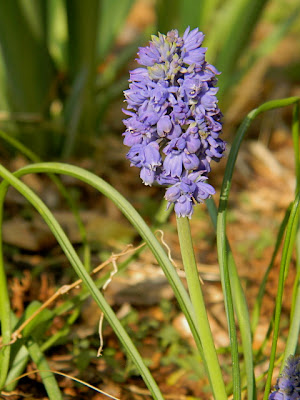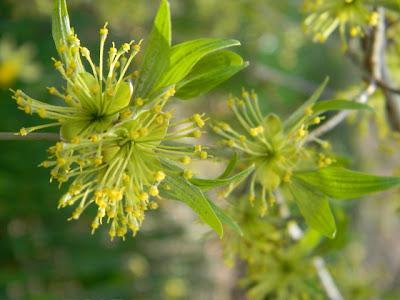The garden has been awake for about a month now, but the magic really starts for me when the native trees begin to leaf out, changing the world from grey to green in a matter of weeks.
As a lover of trees, spring presents one of those unique viewpoints when across the landscape you can pick out species based on colors: red samaras of the maples, light green deciduous leaves of the tulip poplars and sweetgums, dark green needles of the pines, or the showy white dogwoods and magenta redbuds peaking out of the understory. The two largest trees in the picture above are Tulip Poplars (Liriodendron tulipifera), each about 3 feet in diameter, guarding the stream at the edge of our property.
 We are lucky enough to have our little piece of city property back up to an undeveloped easement with a perennial stream. A rare 3 acre unmanaged tract for being within the Raleigh City Limits, it attracts a wide variety of wildlife and has mature second growth hardwoods flanking the stream. The easement is dotted with naturally regenerated dogwoods, this one (right) is at the back of our property, trying to fight through the wisteria. A beautiful mixture of colors for this picture, I will eventually take this vine down because they are so invasive. The only thing stopping me is that the plant was a sentimental gift to the previous homeowner from our neighbor, but I will have to take it out before we move to prevent it from spreading.
We are lucky enough to have our little piece of city property back up to an undeveloped easement with a perennial stream. A rare 3 acre unmanaged tract for being within the Raleigh City Limits, it attracts a wide variety of wildlife and has mature second growth hardwoods flanking the stream. The easement is dotted with naturally regenerated dogwoods, this one (right) is at the back of our property, trying to fight through the wisteria. A beautiful mixture of colors for this picture, I will eventually take this vine down because they are so invasive. The only thing stopping me is that the plant was a sentimental gift to the previous homeowner from our neighbor, but I will have to take it out before we move to prevent it from spreading.In the garden things are moving along at an astonishing pace. With so much rain, the plants have been growing steadily, and on a rare sunny afternoon everything woke up. Warm season herbaceous perennials like this native Culver's Root (Veronicastrum virginicum) (top left) are even making an appearance, just peeking over the newly laid mulch. With passing early spring flowers, the Winter Hazel (Corylopsis glabrescens) (top right) popped open its swelling buds to reveal crinkled new leaves. Even the lawn is blooming! Amid the catastrophic chickweed outbreak we had had this spring are common violets (Viola floridana) (bottom left) showing their faces for the first time this year. Although considered a "weedy" plant in some situations, I leave these little guys alone to set seeds for the songbirds. In the shade garden, the evergreen Sweet Woodruff (Galium odoratum) (bottom right) has recently sent out a flush of new foliage, and with it delicate white flowers with a sweet scent.
A new addition to the garden this spring, the Easter Rose (Kerria japonica 'Honshu') is getting impatient and looks like it will open its buds before the name would suggest. I always love seeing the first flower on a new plant in the garden, and even the buds are beautiful on this one. You may also notice the pollen grains on everything! It is officially that time of year when the waters run yellow with the Loblolly Pine pollen flight. Although the grains of pine pollen are too large to induce allergies, they do make mess on the outdoor furniture. The rains lately have really helped though, hopefully we will have the same luck with the Oak pollen flight that will happen in a couple weeks, one that makes even me fuzzy headed in a bad year.
One of the simple joys I find this time of year is watching the buds swell in the spring and pop to unfurl leaves. The Variegated Beautyberries (Callicarpa dichotoma 'Duet') (left), another new addition this spring, have put on quite a show. The yellow buds and variegation on juvenile leaves is especially exciting to watch progress over the days. The Wine and Roses Wigelia (Wigelia florida 'Wine and Roses') (right) always makes a stunning showing in the spring with its purple-tinged foilage and early buds. Providing a complementary background is a white blooming web of Mazus (Mazus reptans).
I couldn't resist including this pop of color, like I couldn't resist planting these Lorapetalums in our front landscape. A beautiful evergreen specimen plant, these small Chinese Fringe Flowers (Lorapetalum chinensis 'Daruma') only get about 4ft tall, and flush with a purple-maroon growth of foliage as a backdrop for these neon flowers.
Other, less conspicuous blooms are also present in the front landscape. The Rose Glow Barberry (Berberis thunbergii 'Rose Glow') became covered in tiny bell shaped blooms over the last couple days. Even the winter-burnt and possibly disease-ridden Rosemary (Rosmarinus officinado) joined in the fun, offering sparse appearances of white flowers with a touch of violet.
For the final picture I will leave you with the Tulipia 'Little Beauty' that I mentioned in the last post on bulbs. After waiting patiently for 2 days of rain, the budded dwarf tulips opened all at once to greet the sun, and I like to think pose for my pictures too. With more rain in the forecast, and snow for our northern friends, these 'Little Beauties' send spring wishes from our garden!
"It is a wholesome and necessary thing for us to turn again to the earth and in the contemplation of her beauties to know of wonder and humility." ~ Rachel Carson
















































